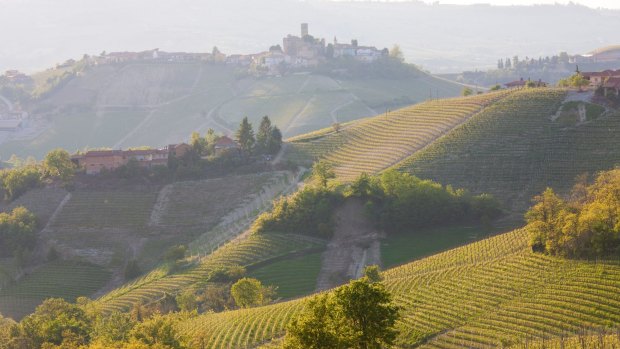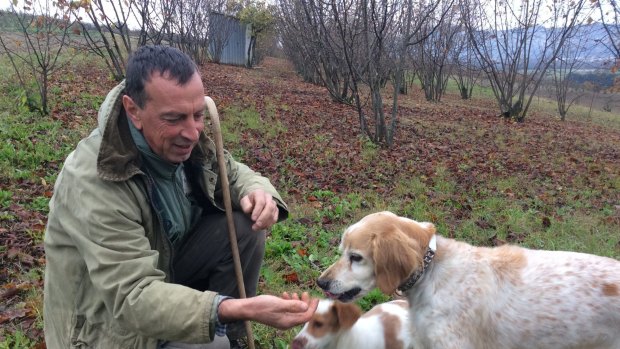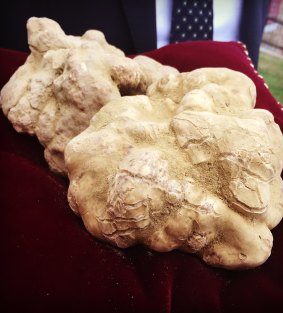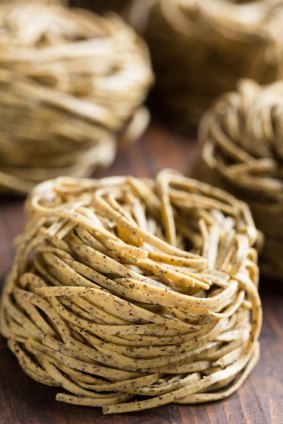This was published 8 years ago
Piedmont, Italy's truffle region: Home of the world's most expensive culinary treasure - white truffle
By Ellen Connolly

A view to Serralunga d'Alba, PiedmontCredit: Alamy
"Guardare bene," Giani says in hushed tones.
"Look good, look good," he repeats encouragingly to Lila, his 10-year-old truffle-hunting dog.
"Where is the truffle?"

Giani and Lila truffle hunting.Credit: Ellen Connolly
Lila, who has a keen nose finely trained to detect the exotic fungi's pungent aroma, sniffs dutifully through the maze of hazelnut trees, the damp ground carpeted in autumn leaves. Joining her is Lady, a two-month-old puppy who is being trained, but who seems more interested in eating fallen hazelnuts than learning.
It does not take long, maybe 10 minutes, before Lila takes off, bolting some 30 metres ahead to claw furiously at the soil, with Giani in hot pursuit.
Giani, a veteran trifulau – he found his first truffle age 5 – needs to ensure Lila does not eat the delectable treasure beneath. Who could blame her?

One of the world's biggest white truffles sold last year for 100,000 euro. Credit: Ellen Connolly
The 51-year-old pushes Lila away, then kneels down as he begins to dig delicately – and deep – into the mud with a hoe known as a sapin, eventually extracting a truffle. Gnarled and milky white, it is the size of a bulb of garlic, if that, yet it is worth 150 times that.
"Fantastico," Giani says, proudly placing the truffle under my nose, its perfume wonderfully intense and intoxicating.
Hailed as the "diamond of the kitchen", the white truffle from Alba is among the most expensive in the world, commanding up to €500 ($700) per 100 grams depending on the quality of the supply. Last year was a good season, at least for gourmands, with the price dropping to €220 per 100 grams.

Tajarin or Tagliolini, made with fresh eggs and buckwheat flour, a specialty pasta from Piedmont. Credit: Alamy
High-end chefs from New York to Paris to Madrid are clamouring to get their hands on the delicacy, and to add it to their menus at exorbitant prices.
The Asian market is in raptures, too. A Hong Kong businessman paid €100,000 ($140,500) for a 1-kilogram white truffle at the annual Alba International White Truffle auction in November.
As the global appetite for truffles grows, so too are tourist numbers in Alba and the surrounding Piedmont region, an area now touted as the tartufo capital of Italy.
From October to December, when Tuber magnatum pico (Alba white truffle) are harvested, the area explodes with visitors. They come for the truffles, the wine, and the restaurants, which include 33 Michelin-star ones.
Truffle season officially kicks off on the first weekend in October with the Alba White Truffle Fair. Now in its 85th year, the giant undercover market, which celebrates all things truffle, is held every weekend until the middle of November.
Packed shoulder to shoulder with visitors, it features many trifulaus selling their produce, as well as Michelin star chef appearances, cooking demonstrations, and wine and food tastings. There are even judges on hand who will examine the truffles bought to ensure quality and freshness.
Alba, in the heart of Piedmont, is where we make our base, staying at the delightful Hotel Calissano, a well-priced four-star establishment which is in walking distance to restaurants and bars.
Our days are, of course, dominated by our next dining opportunity – and truffles.
Unlike black truffles which are used in the cooking process for flavouring, the superior white truffle is always served raw over cooked dishes such as risotto or pasta to allow the fungi's complex yet delicate taste to be appreciated.
At some restaurants, a waiter appeared at our table with a set of electronic scales. The truffle was weighed, the amount noted and then that dreamy sound "Thwack-thwack-thwack" of the truffle showering the dish continued until we said "stop". Be warned it quickly adds up.
Ten grams might not look much but it will set you back €50. Locals say most dishes should contain about 6-8 grams.
Throughout the restaurants of Alba in October and November, a subtle scent of fresh truffles perfumes dining areas.
A restaurant highlight and an obvious local's favourite was Osteria dell'Arco for its traditional yet imaginative menu and its famed panna cotta, the best we have tasted.
The tajarin, egg tagliatelle which is the specialty of Piedmont, at Antica Torre Trattoria was sublime. Our waitress at this old school restaurant served "tajarin alla tartufo", which was washed down with a superb Barbaresco.
On Alba's main square is the 3-Michelin star Piazza Duomo where new wave chef Enrico Crippa presents dishes which are not only extremely pleasing to the palate but visually beautiful.
Two olives were presented, constructed with minced veal and langoustine, a dreamy bowl of fondue – Cocotte Bianco – arrived decorated with white truffles, and Salad 41, named for the number of leaves, edible flowers and herbs it contains. It was served with a small dish of dashi stock, said to promote a youthful appearance. I drank every last drop.
The gastronomic region is famous not only for its truffles but also its hazelnuts. In fact Nutella, that sinfully indulgent chocolate-hazelnut spread, was invented in Alba and the giant Ferrora factory where it is produced employs 4000 locals.
Hazelnuts proved not only a feature of desserts, but during a cooking class at an agriturismo (a farm B&B) with Delphina, we learnt how to make Arrosto Di'lonza alle Nocciole, a traditional dish of roasted pork with hazelnut sauce.
Other must-try dishes of Piedmont are vitello tonnato (cold, thinly sliced veal in a creamy sauce) and the boiled-meat dish, bollito misto.
Then there is the wine tasting. The region is famed for Barolo, Barbera and Barbaresco, and the picturesque countryside is dotted with vineyards, both small, family-run ones and large productions.
Among the top and best known are Ceretto which, after 50 years, has opened its doors to the public, and Gaja, which offers limited guest visits.
Owner Angelo Gaja is passionate about the region, its food and wines, saying: "Truffle season is the glory of this region," but he warns that truffles should not be consumed every day.
"For me it's not possible to have white truffle like an injection in the vein. You need to have something which is precious in moderation."
Giani, who ate his first truffle at age 10, agrees, and says Alba truffles have a special taste and aroma, due to the weather, soil and moon.
He says competition in his profession is fierce, which means he slips into the woods under the cover of darkness, a small lantern under his coat, so as not to alert the other trifulaus of his location.
"We walk four to five hours during the night, in the rain, cold and snow," says Giani, who tells me that "good legs" and "constanti" (persistence) are required.
His biggest find came in 2007 – a 500-gram truffle, worth more than €2500 at the time.
Where was that? I ask.
Giani offers a cheeky grin, waves his hand in a northerly direction and says: "A secret place. On the hills."
TRIP NOTES
MORE INFORMATION
GETTING THERE
Alitalia flies from Sydney to Milan from $1240 return.
STAYING THERE
Hotel Calissano, Alba. Doubles including breakfast from €120 a night see www.hotelcalissano.com
Sign up for the Traveller Deals newsletter
Get exclusive travel deals delivered straight to your inbox. Sign up now.